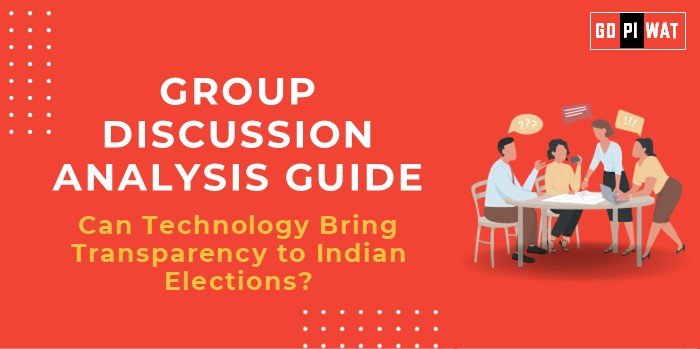📋 Group Discussion Analysis Guide: Can Technology Bring Transparency to Indian Elections?
🌐 Introduction to the Topic
- 📖 Opening Context: In a democracy as vast as India, ensuring transparency in elections is vital to maintain public trust and the integrity of governance. With technology revolutionizing various sectors, its role in enhancing election transparency has become a topic of critical debate.
- 🌍 Topic Background: India has implemented several technological innovations in elections, including electronic voting machines (EVMs), voter-verified paper audit trails (VVPATs), and mobile apps for monitoring. However, the scalability of these technologies and their challenges raise concerns about their effectiveness in ensuring transparency.
📊 Quick Facts and Key Statistics
- 💻 EVM Adoption: 100% in national and state elections since 2004 – significantly reduced manual errors.
- 📈 Voter Turnout: Increased to 67.4% in the 2019 general elections, partly attributed to technology-driven voter outreach (Source: Election Commission of India).
- ⚠️ Cybersecurity Concerns: 62% of surveyed nations face threats to electoral integrity from digital means (Source: UN Digital Security Report, 2023).
- 📱 Real-Time Monitoring: The Election Commission’s cVIGIL app recorded over 3 lakh complaints of violations during the 2019 elections.
🤝 Stakeholders and Their Roles
- ⚖️ Election Commission of India (ECI): Implements and monitors technology in elections.
- 🏛️ Political Parties: Ensure fair use of technology in campaigning and voting processes.
- 👥 Citizens: Utilize technology to report violations and verify information.
- 💻 Technology Providers: Develop secure voting machines and surveillance tools.
- 🌍 International Organizations: Offer best practices and cybersecurity expertise.
🏆 Achievements and Challenges
✨ Achievements:
- ✅ EVM and VVPAT Success: Simplified vote counting and added verifiability.
- 📊 Digital Voter Roll Management: Reduced duplication and ensured accessibility.
- 📱 Mobile Apps (cVIGIL): Empowered citizens to report violations in real time.
- 🌍 Global Benchmarks: Compared favorably with digital initiatives in countries like Estonia and Brazil.
⚠️ Challenges:
- ⚠️ Cybersecurity Risks: Increased vulnerability to hacking and misinformation.
- 📉 Digital Divide: Limited access to tech in rural areas can marginalize voters.
- 💵 Implementation Costs: Significant budgetary allocations required for technology upgrades.
📄 Case Study:
- 📌 2019 Lok Sabha Elections: Technology-driven complaint redressal systems reduced voter fraud, showcasing a scalable model for other democracies.
💡 Structured Arguments for Discussion
- 📢 Supporting Stance: “Technology has enhanced transparency through real-time monitoring and error-free counting, evident from EVMs and VVPATs reducing disputes.”
- ❌ Opposing Stance: “Cybersecurity threats and the digital divide hinder the equitable and transparent implementation of electoral technologies.”
- ⚖️ Balanced Perspective: “While technology enhances transparency, its success depends on bridging the digital divide and addressing cybersecurity vulnerabilities.”
📌 Effective Discussion Approaches
🎯 Opening Approaches:
- 📊 Statistical Evidence: “With over 3 lakh complaints addressed via cVIGIL, technology demonstrates its potential for ensuring electoral transparency.”
- ⚖️ Historical Context: “India’s EVM system, in use since 2004, has reduced counting errors but still faces public skepticism regarding tampering.”
🔄 Counter-Argument Handling:
- 🔒 Cybersecurity Concerns: Propose blockchain technology’s potential for secure voting systems.
- 📱 Digital Divide: Advocate mobile-based solutions adaptable to rural areas.
📚 Strategic Analysis of Strengths and Weaknesses
- 💪 Strengths:
- 📋 Accurate vote counting and reduced manual errors.
- 📱 Enhanced monitoring and citizen empowerment.
- ❌ Weaknesses:
- ⚠️ Cyber risks and potential tampering.
- 📉 Tech illiteracy and rural accessibility issues.
- ✨ Opportunities:
- 🔒 Blockchain integration for secure digital voting.
- 🤖 AI for voter behavior analysis and predictive modeling.
- ⚠️ Threats:
- 📢 Political misuse of technology.
- 📉 Public mistrust in electoral technology.
🎓 Connecting with B-School Applications
🌐 Real-World Applications:
- 📊 Discussions on technology integration in governance and public policy.
- 🔒 Cybersecurity themes in project management and tech-based solutions.
❓ Sample Interview Questions:
- ❓ “What role can blockchain play in ensuring electoral transparency?”
- 💡 “Discuss how technology can address voter apathy in rural areas.”
📈 Insights for Students:
- 📋 Innovate in secure digital solutions for governance.
- 📱 Develop frameworks for equitable technology dissemination.


